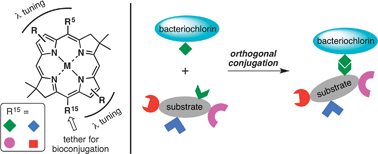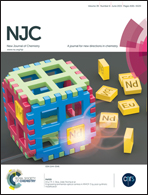Near-infrared tunable bacteriochlorins equipped for bioorthogonal labeling†
Abstract
Bacteriochlorins absorb strongly in the near-infrared (NIR) spectral region and hence may be well suited for photochemical studies ranging from energy sciences to life sciences. To broaden the scope for (bio)molecular labeling, nine lipophilic, wavelength-tunable (729–820 nm) bacteriochlorins (seven free base; two zinc chelates) have been prepared that bear a single bioconjugatable group. The latter include an aldehyde for oxime formation, a maleimido group for thioether formation, an ester or thioester group for traceless Staudinger ligation, or an azido group for click chemistry. NIR wavelength tuning was achieved by installation of auxochromes at the β-pyrrole positions, incorporation of an exocyclic 6-membered imide moiety, or conversion of the free base macrocycle to the zinc chelate. Three synthetic bacteriochlorin building blocks were used to construct the set of bacteriochlorins. Bioconjugatability of target bacteriochlorins was established on small molecules as well as with two tetrapeptides (each containing one non-natural amino acid residue). A 4 × 4 matrix for successive bioorthogonal couplings also was established. Taken together, the studies fulfill two key molecular design criteria (wavelength tunable, bioconjugatable) for use of NIR-active chromophores in a variety of photochemical applications.


 Please wait while we load your content...
Please wait while we load your content...